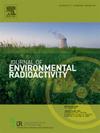Application of RESRAD-OFFSITE code for coastal nuclear facility decommissioning: marine exposure pathway analysis
IF 2.1
3区 环境科学与生态学
Q3 ENVIRONMENTAL SCIENCES
引用次数: 0
Abstract
RESRAD-OFFSITE is a widely used radiation dose assessment code for deriving cleanup criteria and evaluating site release conditions when a nuclear facility is being decommissioned. Its application to coastal nuclear facilities is problematic because it does not consider ingestion of marine products. This study proposes a way to modify RESRAD-OFFSITE so that it can be applied to coastal facilities. We introduce a new parameter, the Seawater Exchange Rate, to quantify the effect of dilution of radioactive materials in the marine environments. We used a three-dimensional ocean model to simulate an idealized coastal area and calculated the Seawater Exchange Rate. We incorporated the obtained Seawater Exchange Rate into RESRAD-OFFSITE's lake submodel (surface water body submodel) and confirmed its validity. Calculations we made at a model site revealed that consideration of dilution via seawater exchange reduced the radiation dose associated with ingestion of marine products. Although this methodology effectively incorporates pathways involving ingestion of marine products using RESRAD-OFFSITE's existing capabilities, implementation of a marine submodel with a Seawater Exchange Rate as a parameter would streamline its practical application.
RESRAD-OFFSITE规范在沿海核设施退役中的应用:海洋暴露路径分析
RESRAD-OFFSITE是一种广泛使用的辐射剂量评估代码,用于制定核设施退役时的清理标准和评估现场释放条件。将其应用于沿海核设施是有问题的,因为它没有考虑到海洋产品的摄入。本研究提出了一种改进RESRAD-OFFSITE的方法,使其可以应用于沿海设施。我们引入了一个新的参数,海水交换率,以量化海洋环境中放射性物质稀释的影响。我们用三维海洋模型模拟了一个理想的沿海地区,并计算了海水交换率。我们将所得的海水交换率纳入RESRAD-OFFSITE的湖泊子模型(地表水体子模型),验证了其有效性。我们在一个模型地点进行的计算表明,考虑通过海水交换进行稀释,可以减少与摄入海产品有关的辐射剂量。尽管该方法利用RESRAD-OFFSITE的现有能力有效地整合了涉及海洋产品摄入的途径,但以海水交换率为参数的海洋子模型的实施将简化其实际应用。
本文章由计算机程序翻译,如有差异,请以英文原文为准。
求助全文
约1分钟内获得全文
求助全文
来源期刊

Journal of environmental radioactivity
环境科学-环境科学
CiteScore
4.70
自引率
13.00%
发文量
209
审稿时长
73 days
期刊介绍:
The Journal of Environmental Radioactivity provides a coherent international forum for publication of original research or review papers on any aspect of the occurrence of radioactivity in natural systems.
Relevant subject areas range from applications of environmental radionuclides as mechanistic or timescale tracers of natural processes to assessments of the radioecological or radiological effects of ambient radioactivity. Papers deal with naturally occurring nuclides or with those created and released by man through nuclear weapons manufacture and testing, energy production, fuel-cycle technology, etc. Reports on radioactivity in the oceans, sediments, rivers, lakes, groundwaters, soils, atmosphere and all divisions of the biosphere are welcomed, but these should not simply be of a monitoring nature unless the data are particularly innovative.
 求助内容:
求助内容: 应助结果提醒方式:
应助结果提醒方式:


